Project Integration Report: Project Management for ERP Implementation
VerifiedAdded on 2022/12/28
|11
|1935
|65
Report
AI Summary
This report details a project aimed at integrating Enterprise Resource Planning (ERP) software to improve operational efficiency and data integration across various departments. The project involves the installation of ERP software, employee training, and the establishment of a new integrated system to streamline data flow. The report outlines the project initiation document, project description, governance structure, objectives, key deliverables, constraints, assumptions, initial risks, milestone schedule, and budget summary. It also describes the project methodology, which utilizes the PMI/PMBOK framework, and the project lifecycle. The project's objectives include improving cash management, sales operations, production, warehouse management, and transportation. The report also addresses potential constraints such as training inefficiencies, the high cost of ERP systems, customization limitations, long implementation times, and the interconnection of departments. The initial risks associated with the project, such as data leakage and software bugs, are also discussed.
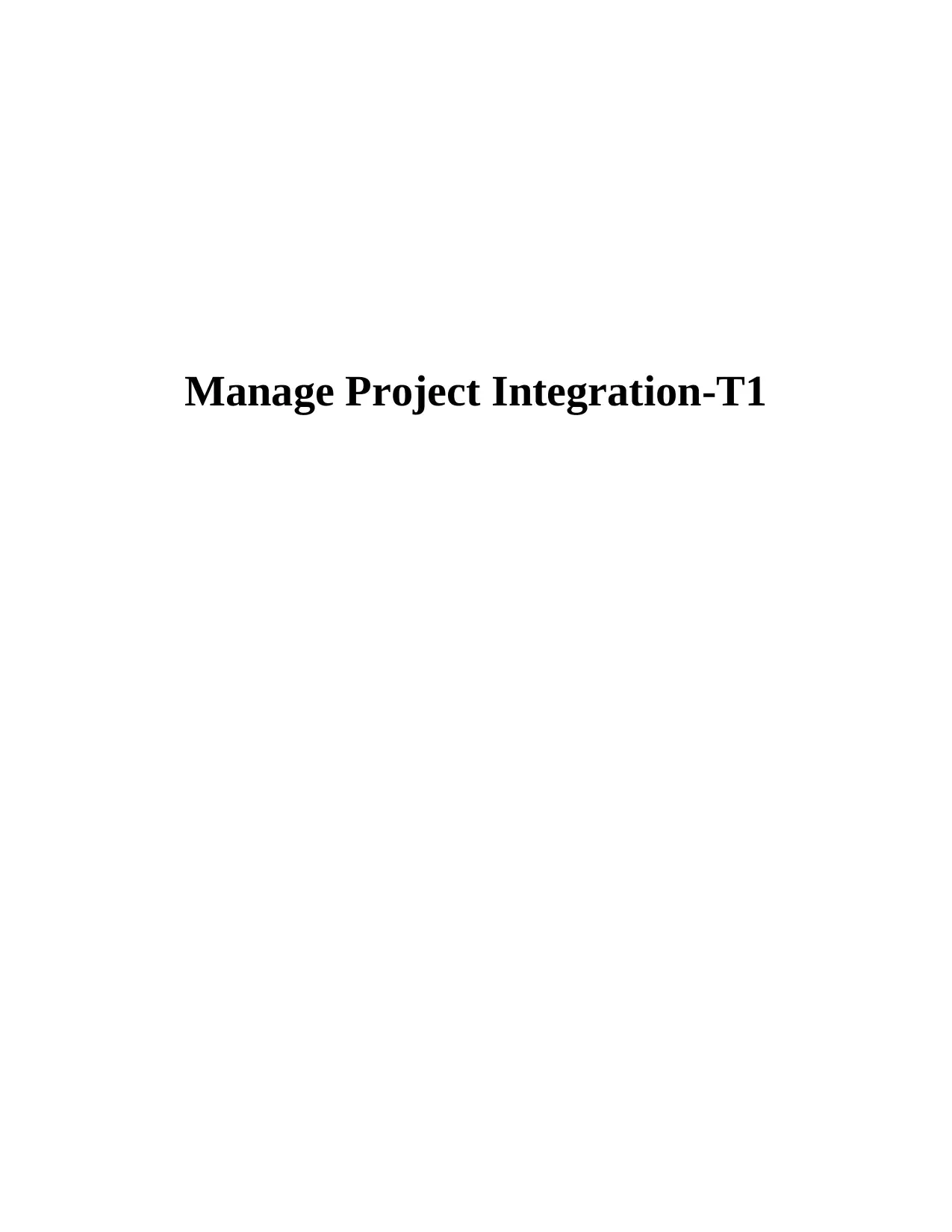
Manage Project Integration-T1
Paraphrase This Document
Need a fresh take? Get an instant paraphrase of this document with our AI Paraphraser
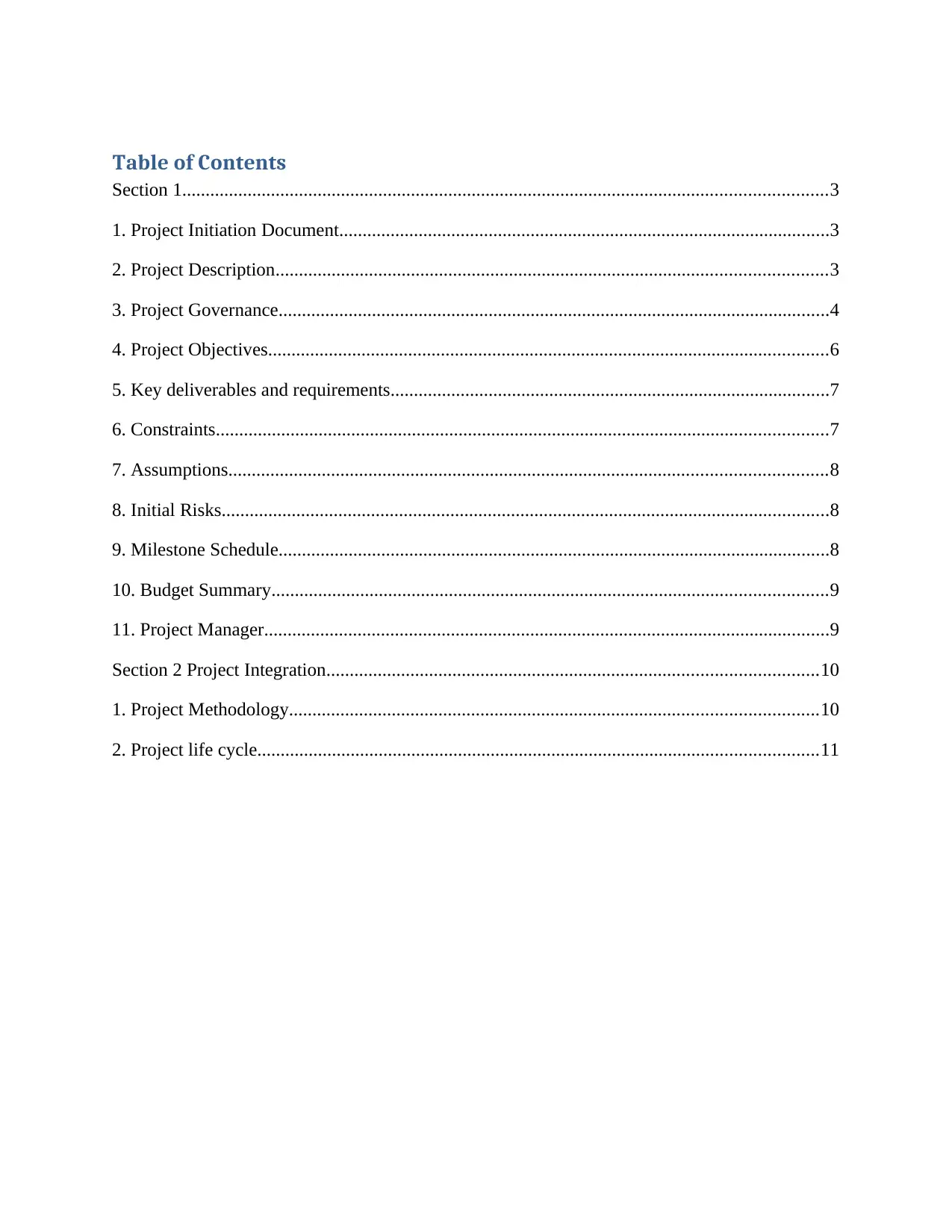
Table of Contents
Section 1..........................................................................................................................................3
1. Project Initiation Document.........................................................................................................3
2. Project Description......................................................................................................................3
3. Project Governance......................................................................................................................4
4. Project Objectives........................................................................................................................6
5. Key deliverables and requirements..............................................................................................7
6. Constraints...................................................................................................................................7
7. Assumptions................................................................................................................................8
8. Initial Risks..................................................................................................................................8
9. Milestone Schedule......................................................................................................................8
10. Budget Summary.......................................................................................................................9
11. Project Manager.........................................................................................................................9
Section 2 Project Integration.........................................................................................................10
1. Project Methodology.................................................................................................................10
2. Project life cycle........................................................................................................................11
Section 1..........................................................................................................................................3
1. Project Initiation Document.........................................................................................................3
2. Project Description......................................................................................................................3
3. Project Governance......................................................................................................................4
4. Project Objectives........................................................................................................................6
5. Key deliverables and requirements..............................................................................................7
6. Constraints...................................................................................................................................7
7. Assumptions................................................................................................................................8
8. Initial Risks..................................................................................................................................8
9. Milestone Schedule......................................................................................................................8
10. Budget Summary.......................................................................................................................9
11. Project Manager.........................................................................................................................9
Section 2 Project Integration.........................................................................................................10
1. Project Methodology.................................................................................................................10
2. Project life cycle........................................................................................................................11
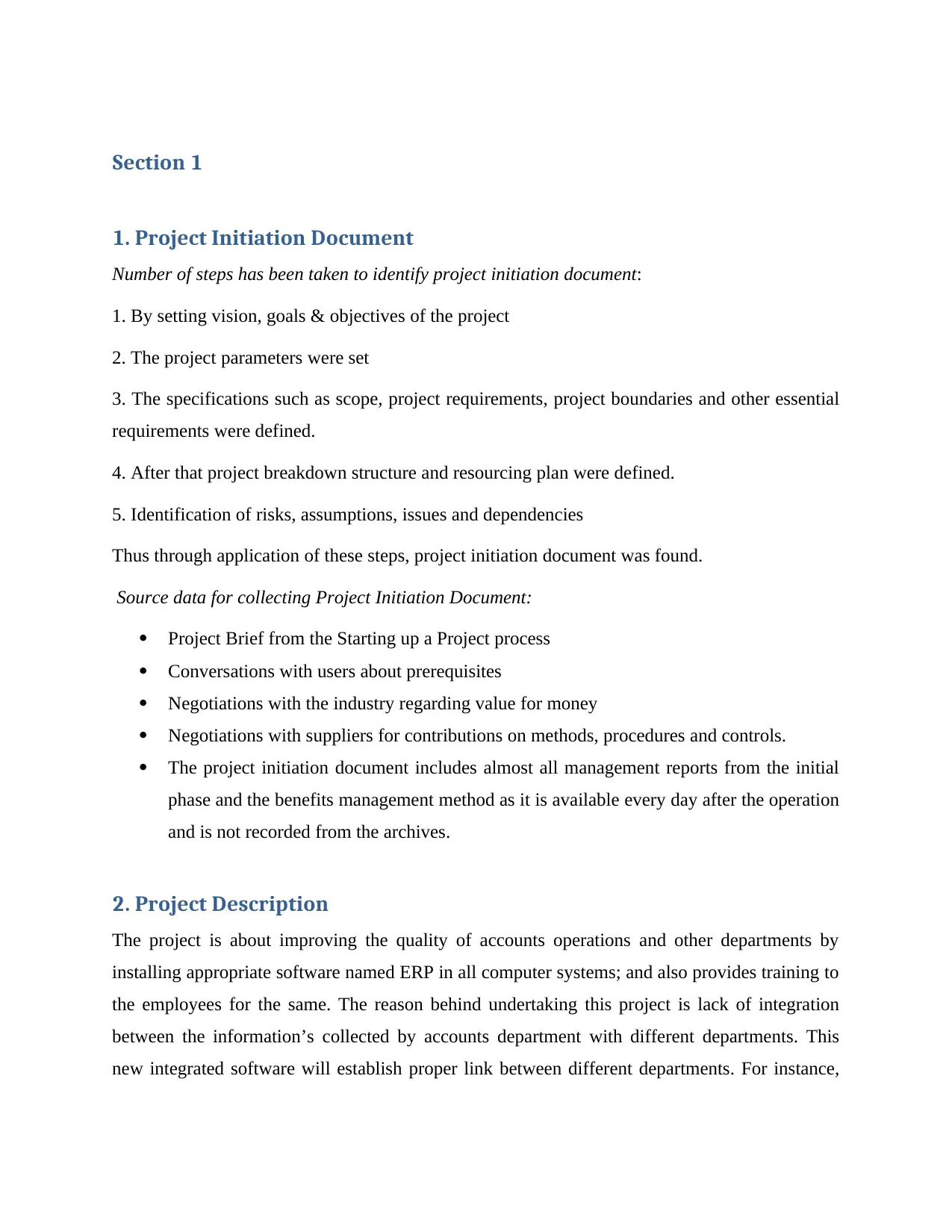
Section 1
1. Project Initiation Document
Number of steps has been taken to identify project initiation document:
1. By setting vision, goals & objectives of the project
2. The project parameters were set
3. The specifications such as scope, project requirements, project boundaries and other essential
requirements were defined.
4. After that project breakdown structure and resourcing plan were defined.
5. Identification of risks, assumptions, issues and dependencies
Thus through application of these steps, project initiation document was found.
Source data for collecting Project Initiation Document:
Project Brief from the Starting up a Project process
Conversations with users about prerequisites
Negotiations with the industry regarding value for money
Negotiations with suppliers for contributions on methods, procedures and controls.
The project initiation document includes almost all management reports from the initial
phase and the benefits management method as it is available every day after the operation
and is not recorded from the archives.
2. Project Description
The project is about improving the quality of accounts operations and other departments by
installing appropriate software named ERP in all computer systems; and also provides training to
the employees for the same. The reason behind undertaking this project is lack of integration
between the information’s collected by accounts department with different departments. This
new integrated software will establish proper link between different departments. For instance,
1. Project Initiation Document
Number of steps has been taken to identify project initiation document:
1. By setting vision, goals & objectives of the project
2. The project parameters were set
3. The specifications such as scope, project requirements, project boundaries and other essential
requirements were defined.
4. After that project breakdown structure and resourcing plan were defined.
5. Identification of risks, assumptions, issues and dependencies
Thus through application of these steps, project initiation document was found.
Source data for collecting Project Initiation Document:
Project Brief from the Starting up a Project process
Conversations with users about prerequisites
Negotiations with the industry regarding value for money
Negotiations with suppliers for contributions on methods, procedures and controls.
The project initiation document includes almost all management reports from the initial
phase and the benefits management method as it is available every day after the operation
and is not recorded from the archives.
2. Project Description
The project is about improving the quality of accounts operations and other departments by
installing appropriate software named ERP in all computer systems; and also provides training to
the employees for the same. The reason behind undertaking this project is lack of integration
between the information’s collected by accounts department with different departments. This
new integrated software will establish proper link between different departments. For instance,
⊘ This is a preview!⊘
Do you want full access?
Subscribe today to unlock all pages.

Trusted by 1+ million students worldwide
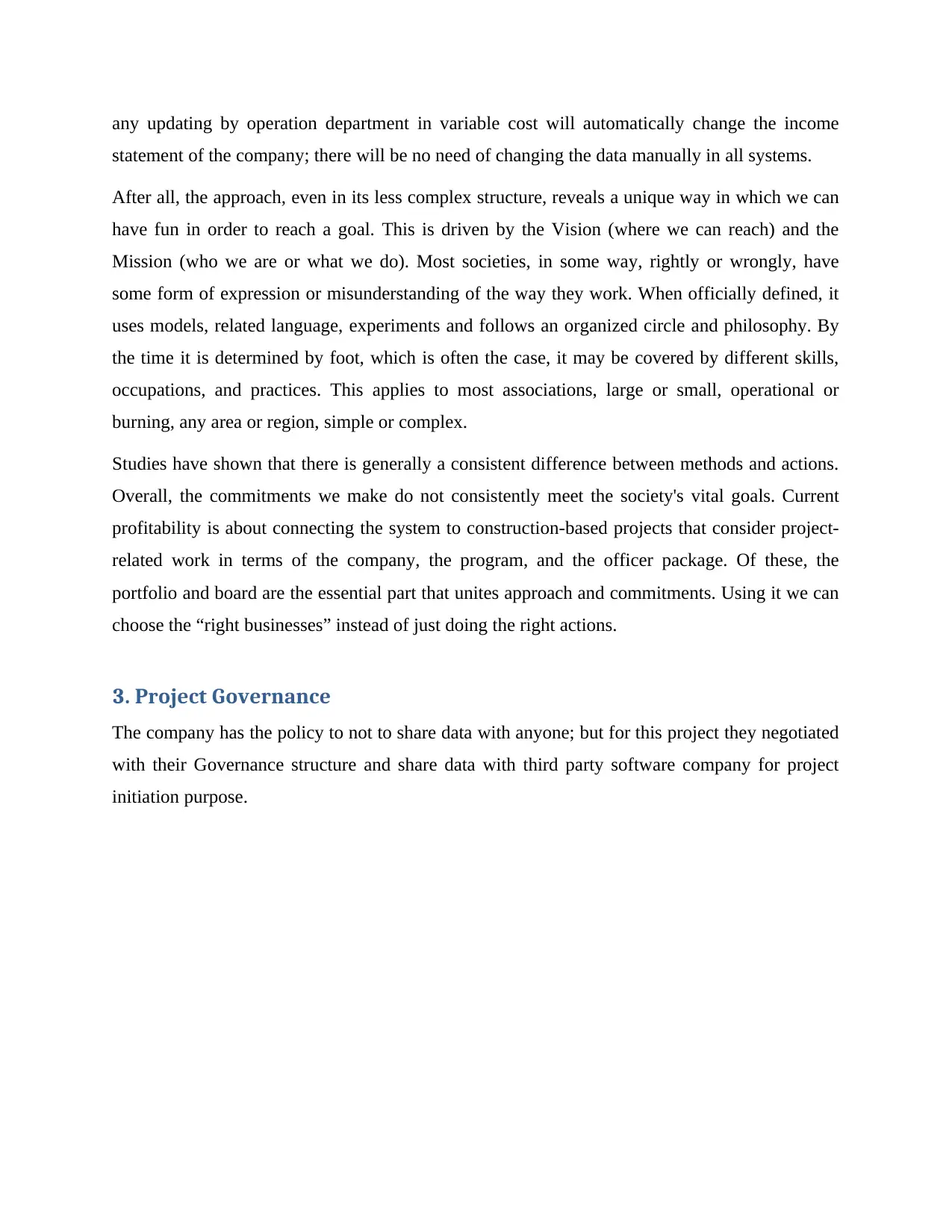
any updating by operation department in variable cost will automatically change the income
statement of the company; there will be no need of changing the data manually in all systems.
After all, the approach, even in its less complex structure, reveals a unique way in which we can
have fun in order to reach a goal. This is driven by the Vision (where we can reach) and the
Mission (who we are or what we do). Most societies, in some way, rightly or wrongly, have
some form of expression or misunderstanding of the way they work. When officially defined, it
uses models, related language, experiments and follows an organized circle and philosophy. By
the time it is determined by foot, which is often the case, it may be covered by different skills,
occupations, and practices. This applies to most associations, large or small, operational or
burning, any area or region, simple or complex.
Studies have shown that there is generally a consistent difference between methods and actions.
Overall, the commitments we make do not consistently meet the society's vital goals. Current
profitability is about connecting the system to construction-based projects that consider project-
related work in terms of the company, the program, and the officer package. Of these, the
portfolio and board are the essential part that unites approach and commitments. Using it we can
choose the “right businesses” instead of just doing the right actions.
3. Project Governance
The company has the policy to not to share data with anyone; but for this project they negotiated
with their Governance structure and share data with third party software company for project
initiation purpose.
statement of the company; there will be no need of changing the data manually in all systems.
After all, the approach, even in its less complex structure, reveals a unique way in which we can
have fun in order to reach a goal. This is driven by the Vision (where we can reach) and the
Mission (who we are or what we do). Most societies, in some way, rightly or wrongly, have
some form of expression or misunderstanding of the way they work. When officially defined, it
uses models, related language, experiments and follows an organized circle and philosophy. By
the time it is determined by foot, which is often the case, it may be covered by different skills,
occupations, and practices. This applies to most associations, large or small, operational or
burning, any area or region, simple or complex.
Studies have shown that there is generally a consistent difference between methods and actions.
Overall, the commitments we make do not consistently meet the society's vital goals. Current
profitability is about connecting the system to construction-based projects that consider project-
related work in terms of the company, the program, and the officer package. Of these, the
portfolio and board are the essential part that unites approach and commitments. Using it we can
choose the “right businesses” instead of just doing the right actions.
3. Project Governance
The company has the policy to not to share data with anyone; but for this project they negotiated
with their Governance structure and share data with third party software company for project
initiation purpose.
Paraphrase This Document
Need a fresh take? Get an instant paraphrase of this document with our AI Paraphraser
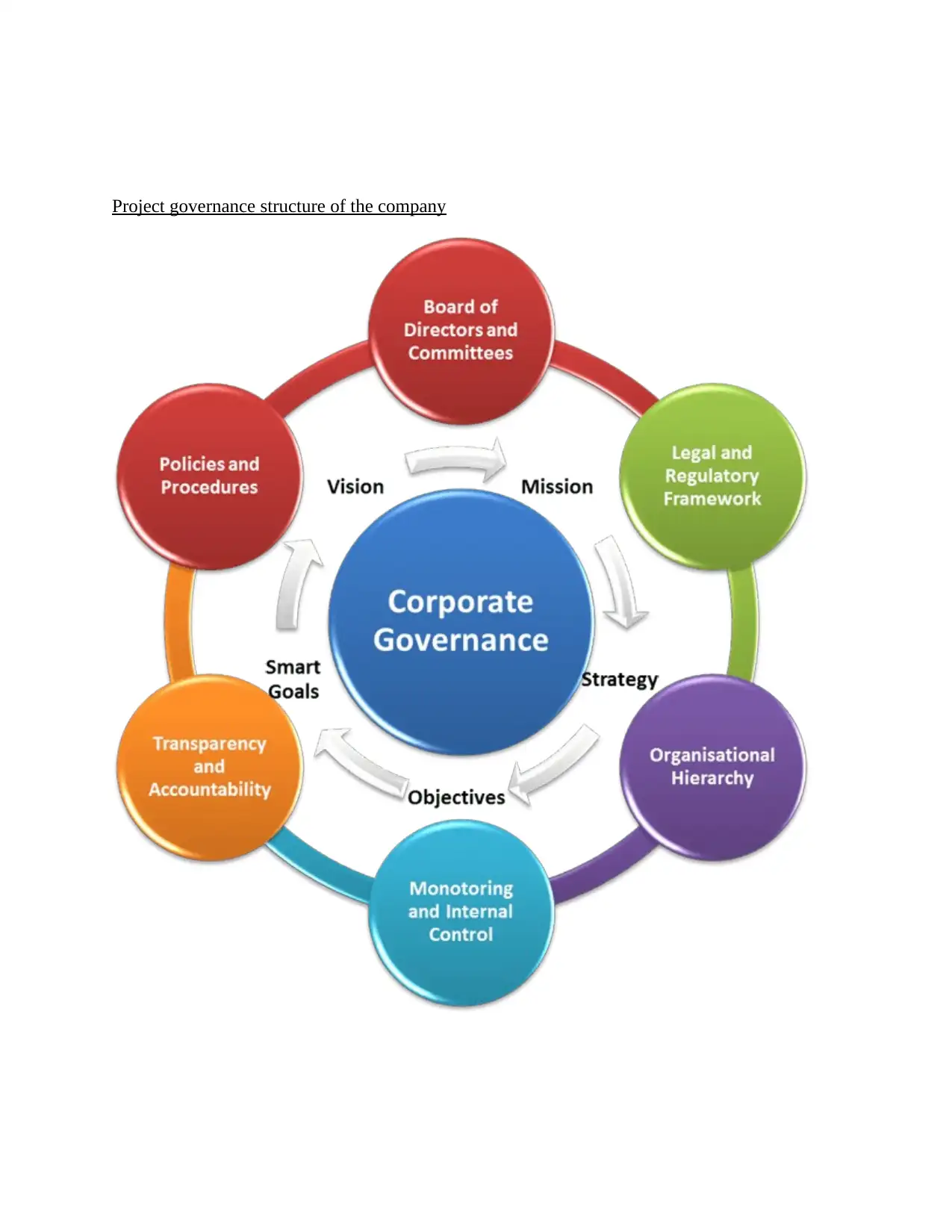
Project governance structure of the company
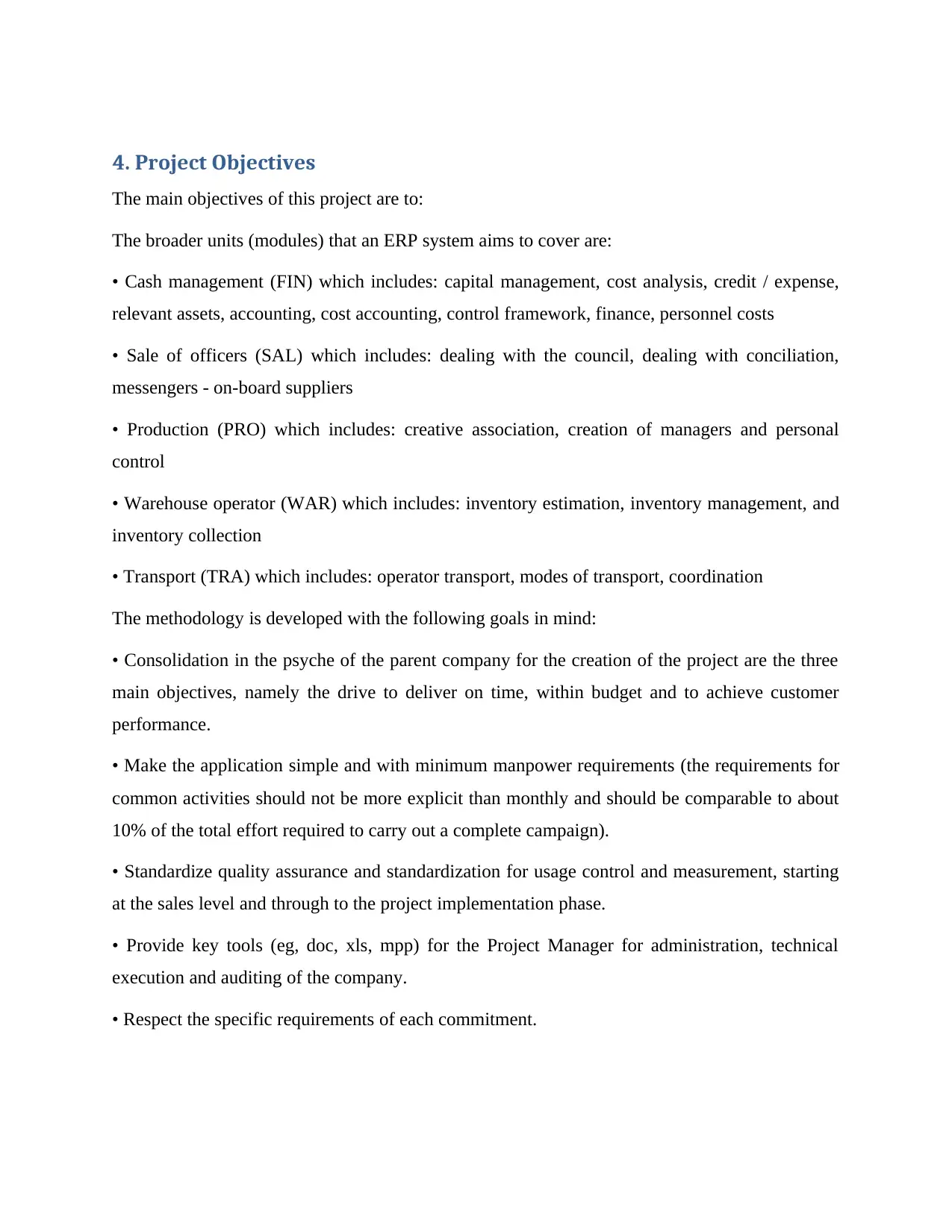
4. Project Objectives
The main objectives of this project are to:
The broader units (modules) that an ERP system aims to cover are:
• Cash management (FIN) which includes: capital management, cost analysis, credit / expense,
relevant assets, accounting, cost accounting, control framework, finance, personnel costs
• Sale of officers (SAL) which includes: dealing with the council, dealing with conciliation,
messengers - on-board suppliers
• Production (PRO) which includes: creative association, creation of managers and personal
control
• Warehouse operator (WAR) which includes: inventory estimation, inventory management, and
inventory collection
• Transport (TRA) which includes: operator transport, modes of transport, coordination
The methodology is developed with the following goals in mind:
• Consolidation in the psyche of the parent company for the creation of the project are the three
main objectives, namely the drive to deliver on time, within budget and to achieve customer
performance.
• Make the application simple and with minimum manpower requirements (the requirements for
common activities should not be more explicit than monthly and should be comparable to about
10% of the total effort required to carry out a complete campaign).
• Standardize quality assurance and standardization for usage control and measurement, starting
at the sales level and through to the project implementation phase.
• Provide key tools (eg, doc, xls, mpp) for the Project Manager for administration, technical
execution and auditing of the company.
• Respect the specific requirements of each commitment.
The main objectives of this project are to:
The broader units (modules) that an ERP system aims to cover are:
• Cash management (FIN) which includes: capital management, cost analysis, credit / expense,
relevant assets, accounting, cost accounting, control framework, finance, personnel costs
• Sale of officers (SAL) which includes: dealing with the council, dealing with conciliation,
messengers - on-board suppliers
• Production (PRO) which includes: creative association, creation of managers and personal
control
• Warehouse operator (WAR) which includes: inventory estimation, inventory management, and
inventory collection
• Transport (TRA) which includes: operator transport, modes of transport, coordination
The methodology is developed with the following goals in mind:
• Consolidation in the psyche of the parent company for the creation of the project are the three
main objectives, namely the drive to deliver on time, within budget and to achieve customer
performance.
• Make the application simple and with minimum manpower requirements (the requirements for
common activities should not be more explicit than monthly and should be comparable to about
10% of the total effort required to carry out a complete campaign).
• Standardize quality assurance and standardization for usage control and measurement, starting
at the sales level and through to the project implementation phase.
• Provide key tools (eg, doc, xls, mpp) for the Project Manager for administration, technical
execution and auditing of the company.
• Respect the specific requirements of each commitment.
⊘ This is a preview!⊘
Do you want full access?
Subscribe today to unlock all pages.

Trusted by 1+ million students worldwide
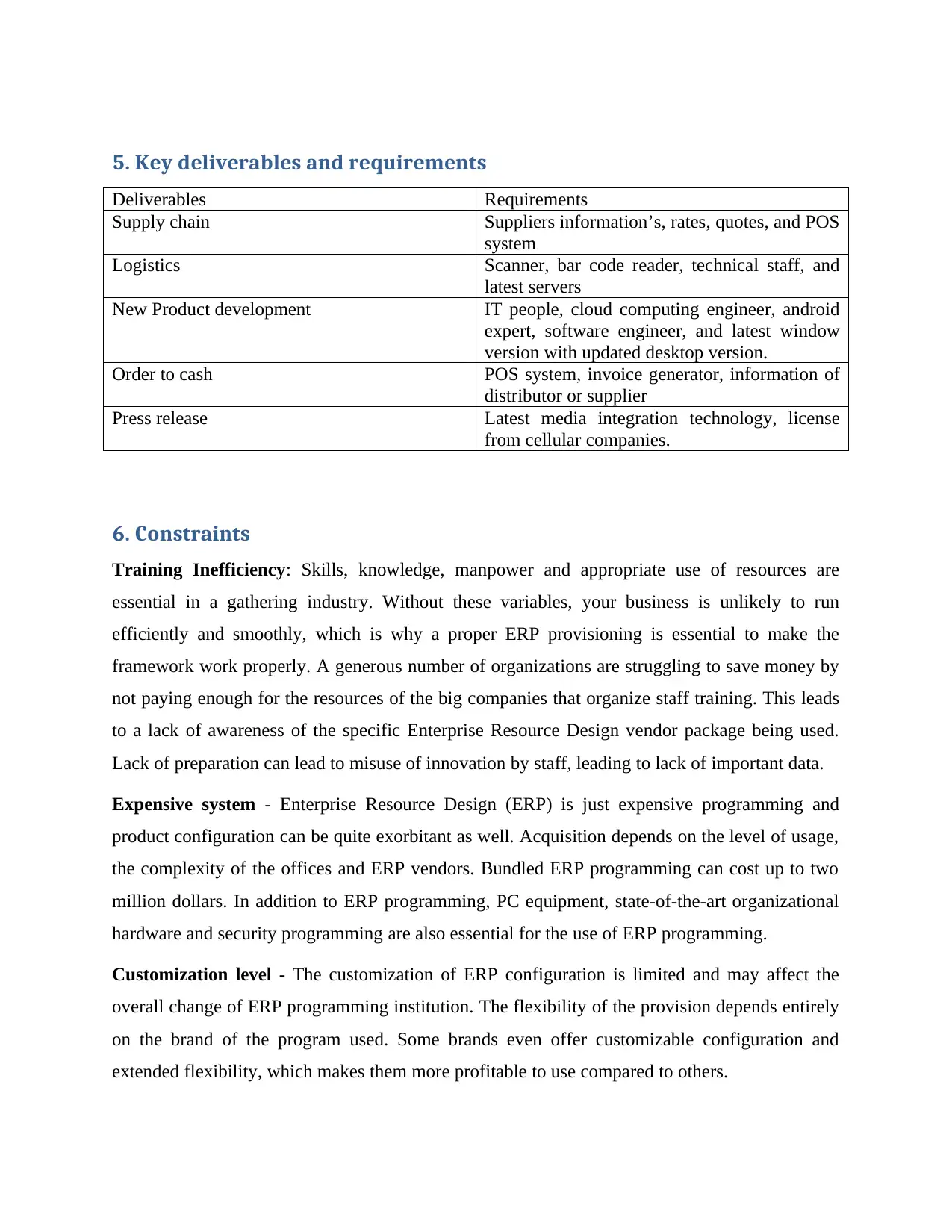
5. Key deliverables and requirements
Deliverables Requirements
Supply chain Suppliers information’s, rates, quotes, and POS
system
Logistics Scanner, bar code reader, technical staff, and
latest servers
New Product development IT people, cloud computing engineer, android
expert, software engineer, and latest window
version with updated desktop version.
Order to cash POS system, invoice generator, information of
distributor or supplier
Press release Latest media integration technology, license
from cellular companies.
6. Constraints
Training Inefficiency: Skills, knowledge, manpower and appropriate use of resources are
essential in a gathering industry. Without these variables, your business is unlikely to run
efficiently and smoothly, which is why a proper ERP provisioning is essential to make the
framework work properly. A generous number of organizations are struggling to save money by
not paying enough for the resources of the big companies that organize staff training. This leads
to a lack of awareness of the specific Enterprise Resource Design vendor package being used.
Lack of preparation can lead to misuse of innovation by staff, leading to lack of important data.
Expensive system - Enterprise Resource Design (ERP) is just expensive programming and
product configuration can be quite exorbitant as well. Acquisition depends on the level of usage,
the complexity of the offices and ERP vendors. Bundled ERP programming can cost up to two
million dollars. In addition to ERP programming, PC equipment, state-of-the-art organizational
hardware and security programming are also essential for the use of ERP programming.
Customization level - The customization of ERP configuration is limited and may affect the
overall change of ERP programming institution. The flexibility of the provision depends entirely
on the brand of the program used. Some brands even offer customizable configuration and
extended flexibility, which makes them more profitable to use compared to others.
Deliverables Requirements
Supply chain Suppliers information’s, rates, quotes, and POS
system
Logistics Scanner, bar code reader, technical staff, and
latest servers
New Product development IT people, cloud computing engineer, android
expert, software engineer, and latest window
version with updated desktop version.
Order to cash POS system, invoice generator, information of
distributor or supplier
Press release Latest media integration technology, license
from cellular companies.
6. Constraints
Training Inefficiency: Skills, knowledge, manpower and appropriate use of resources are
essential in a gathering industry. Without these variables, your business is unlikely to run
efficiently and smoothly, which is why a proper ERP provisioning is essential to make the
framework work properly. A generous number of organizations are struggling to save money by
not paying enough for the resources of the big companies that organize staff training. This leads
to a lack of awareness of the specific Enterprise Resource Design vendor package being used.
Lack of preparation can lead to misuse of innovation by staff, leading to lack of important data.
Expensive system - Enterprise Resource Design (ERP) is just expensive programming and
product configuration can be quite exorbitant as well. Acquisition depends on the level of usage,
the complexity of the offices and ERP vendors. Bundled ERP programming can cost up to two
million dollars. In addition to ERP programming, PC equipment, state-of-the-art organizational
hardware and security programming are also essential for the use of ERP programming.
Customization level - The customization of ERP configuration is limited and may affect the
overall change of ERP programming institution. The flexibility of the provision depends entirely
on the brand of the program used. Some brands even offer customizable configuration and
extended flexibility, which makes them more profitable to use compared to others.
Paraphrase This Document
Need a fresh take? Get an instant paraphrase of this document with our AI Paraphraser
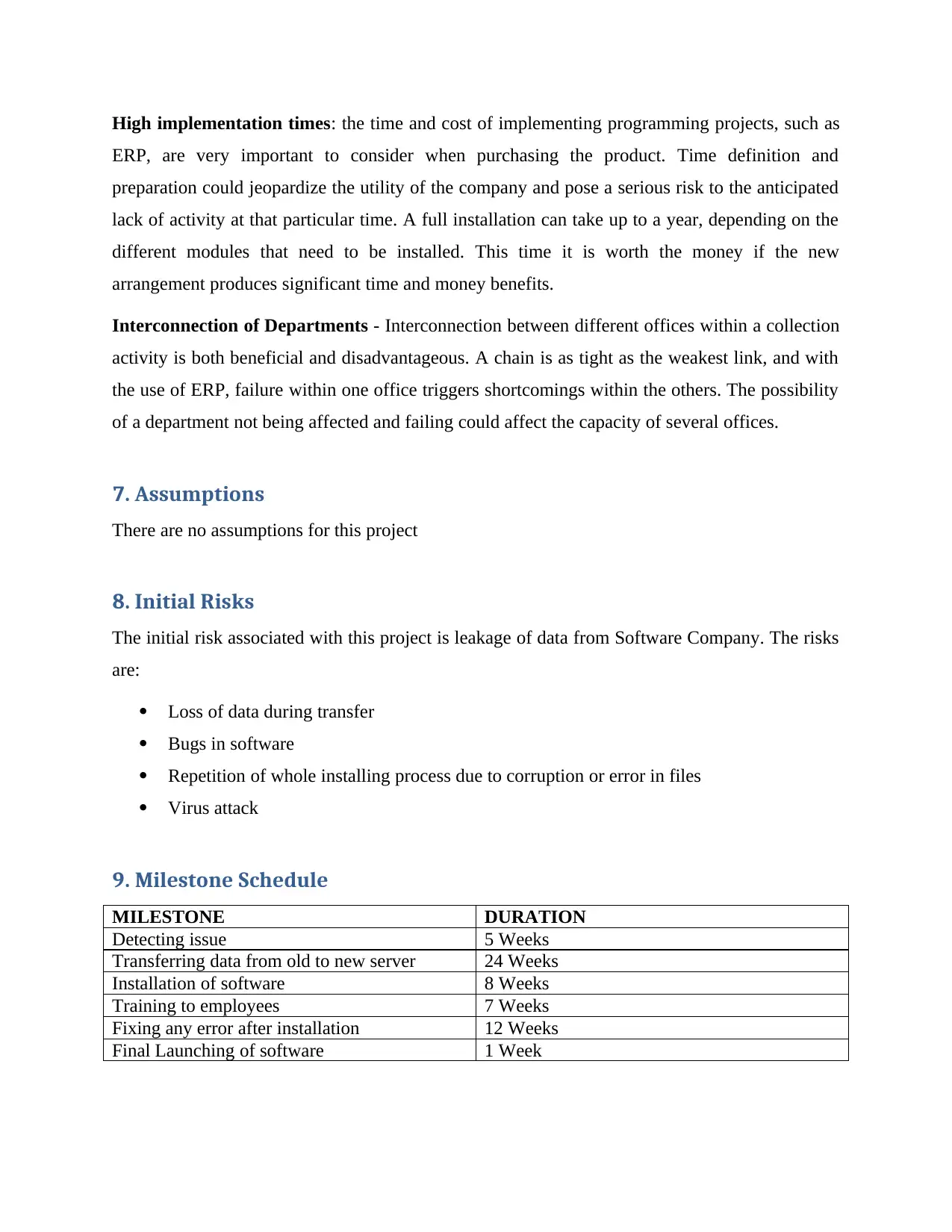
High implementation times: the time and cost of implementing programming projects, such as
ERP, are very important to consider when purchasing the product. Time definition and
preparation could jeopardize the utility of the company and pose a serious risk to the anticipated
lack of activity at that particular time. A full installation can take up to a year, depending on the
different modules that need to be installed. This time it is worth the money if the new
arrangement produces significant time and money benefits.
Interconnection of Departments - Interconnection between different offices within a collection
activity is both beneficial and disadvantageous. A chain is as tight as the weakest link, and with
the use of ERP, failure within one office triggers shortcomings within the others. The possibility
of a department not being affected and failing could affect the capacity of several offices.
7. Assumptions
There are no assumptions for this project
8. Initial Risks
The initial risk associated with this project is leakage of data from Software Company. The risks
are:
Loss of data during transfer
Bugs in software
Repetition of whole installing process due to corruption or error in files
Virus attack
9. Milestone Schedule
MILESTONE DURATION
Detecting issue 5 Weeks
Transferring data from old to new server 24 Weeks
Installation of software 8 Weeks
Training to employees 7 Weeks
Fixing any error after installation 12 Weeks
Final Launching of software 1 Week
ERP, are very important to consider when purchasing the product. Time definition and
preparation could jeopardize the utility of the company and pose a serious risk to the anticipated
lack of activity at that particular time. A full installation can take up to a year, depending on the
different modules that need to be installed. This time it is worth the money if the new
arrangement produces significant time and money benefits.
Interconnection of Departments - Interconnection between different offices within a collection
activity is both beneficial and disadvantageous. A chain is as tight as the weakest link, and with
the use of ERP, failure within one office triggers shortcomings within the others. The possibility
of a department not being affected and failing could affect the capacity of several offices.
7. Assumptions
There are no assumptions for this project
8. Initial Risks
The initial risk associated with this project is leakage of data from Software Company. The risks
are:
Loss of data during transfer
Bugs in software
Repetition of whole installing process due to corruption or error in files
Virus attack
9. Milestone Schedule
MILESTONE DURATION
Detecting issue 5 Weeks
Transferring data from old to new server 24 Weeks
Installation of software 8 Weeks
Training to employees 7 Weeks
Fixing any error after installation 12 Weeks
Final Launching of software 1 Week
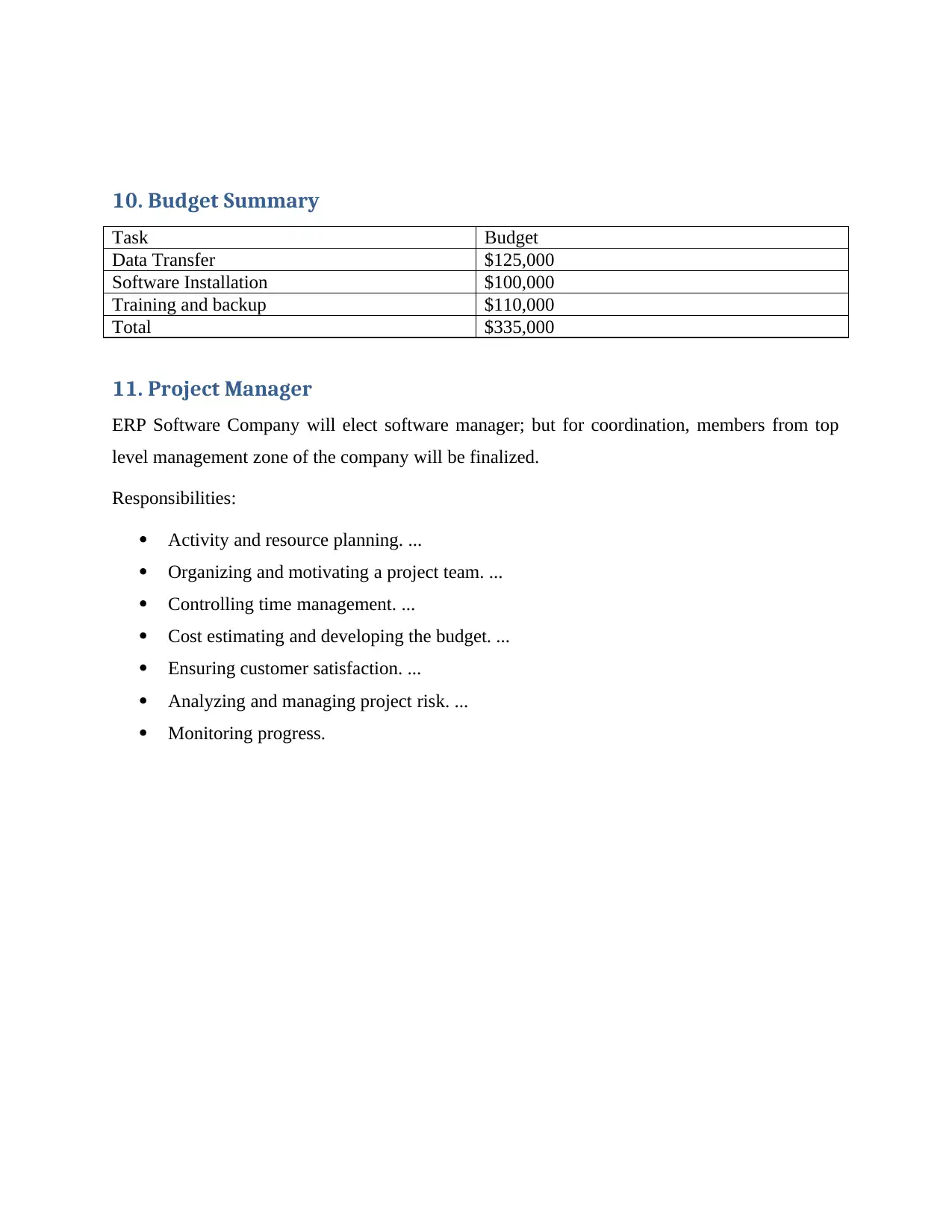
10. Budget Summary
Task Budget
Data Transfer $125,000
Software Installation $100,000
Training and backup $110,000
Total $335,000
11. Project Manager
ERP Software Company will elect software manager; but for coordination, members from top
level management zone of the company will be finalized.
Responsibilities:
Activity and resource planning. ...
Organizing and motivating a project team. ...
Controlling time management. ...
Cost estimating and developing the budget. ...
Ensuring customer satisfaction. ...
Analyzing and managing project risk. ...
Monitoring progress.
Task Budget
Data Transfer $125,000
Software Installation $100,000
Training and backup $110,000
Total $335,000
11. Project Manager
ERP Software Company will elect software manager; but for coordination, members from top
level management zone of the company will be finalized.
Responsibilities:
Activity and resource planning. ...
Organizing and motivating a project team. ...
Controlling time management. ...
Cost estimating and developing the budget. ...
Ensuring customer satisfaction. ...
Analyzing and managing project risk. ...
Monitoring progress.
⊘ This is a preview!⊘
Do you want full access?
Subscribe today to unlock all pages.

Trusted by 1+ million students worldwide
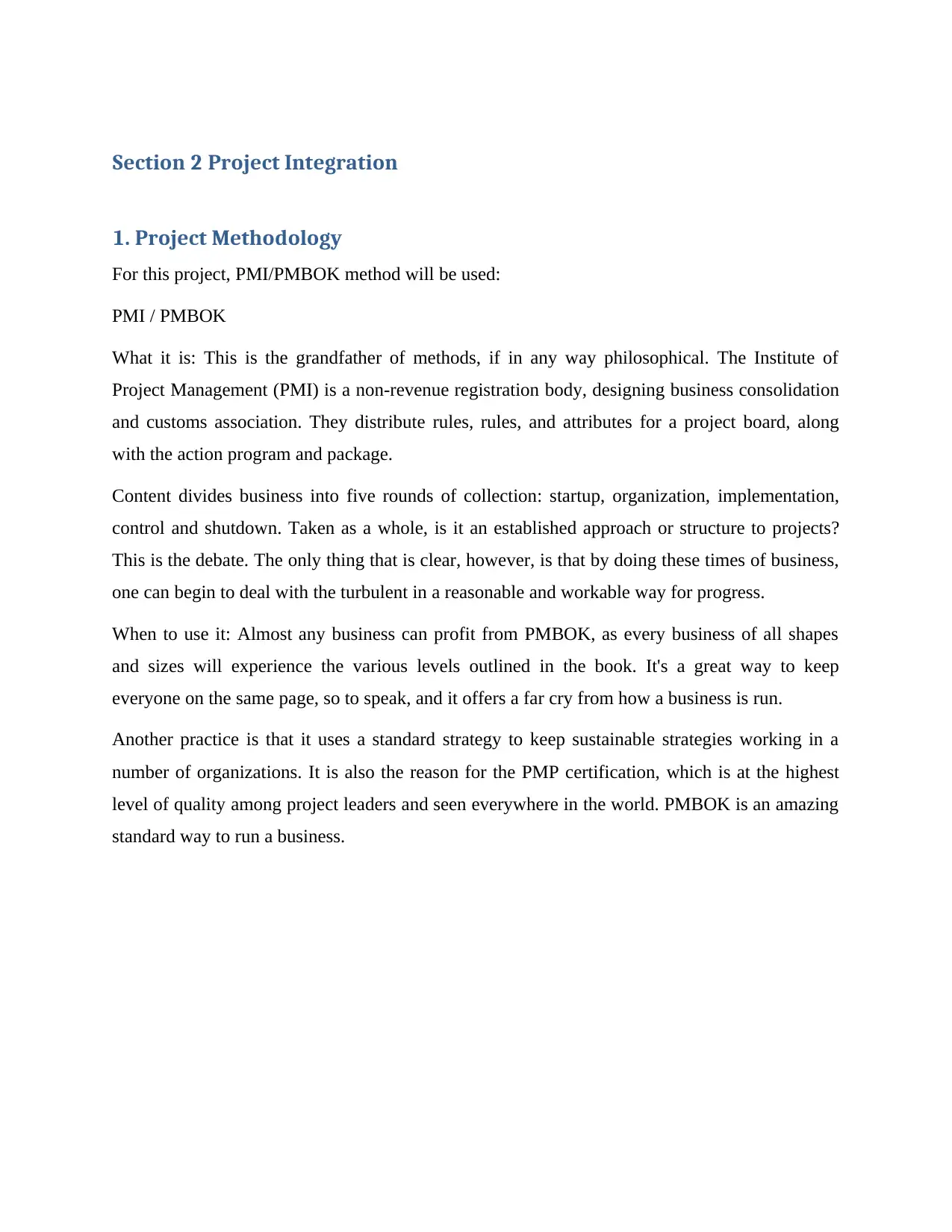
Section 2 Project Integration
1. Project Methodology
For this project, PMI/PMBOK method will be used:
PMI / PMBOK
What it is: This is the grandfather of methods, if in any way philosophical. The Institute of
Project Management (PMI) is a non-revenue registration body, designing business consolidation
and customs association. They distribute rules, rules, and attributes for a project board, along
with the action program and package.
Content divides business into five rounds of collection: startup, organization, implementation,
control and shutdown. Taken as a whole, is it an established approach or structure to projects?
This is the debate. The only thing that is clear, however, is that by doing these times of business,
one can begin to deal with the turbulent in a reasonable and workable way for progress.
When to use it: Almost any business can profit from PMBOK, as every business of all shapes
and sizes will experience the various levels outlined in the book. It's a great way to keep
everyone on the same page, so to speak, and it offers a far cry from how a business is run.
Another practice is that it uses a standard strategy to keep sustainable strategies working in a
number of organizations. It is also the reason for the PMP certification, which is at the highest
level of quality among project leaders and seen everywhere in the world. PMBOK is an amazing
standard way to run a business.
1. Project Methodology
For this project, PMI/PMBOK method will be used:
PMI / PMBOK
What it is: This is the grandfather of methods, if in any way philosophical. The Institute of
Project Management (PMI) is a non-revenue registration body, designing business consolidation
and customs association. They distribute rules, rules, and attributes for a project board, along
with the action program and package.
Content divides business into five rounds of collection: startup, organization, implementation,
control and shutdown. Taken as a whole, is it an established approach or structure to projects?
This is the debate. The only thing that is clear, however, is that by doing these times of business,
one can begin to deal with the turbulent in a reasonable and workable way for progress.
When to use it: Almost any business can profit from PMBOK, as every business of all shapes
and sizes will experience the various levels outlined in the book. It's a great way to keep
everyone on the same page, so to speak, and it offers a far cry from how a business is run.
Another practice is that it uses a standard strategy to keep sustainable strategies working in a
number of organizations. It is also the reason for the PMP certification, which is at the highest
level of quality among project leaders and seen everywhere in the world. PMBOK is an amazing
standard way to run a business.
Paraphrase This Document
Need a fresh take? Get an instant paraphrase of this document with our AI Paraphraser
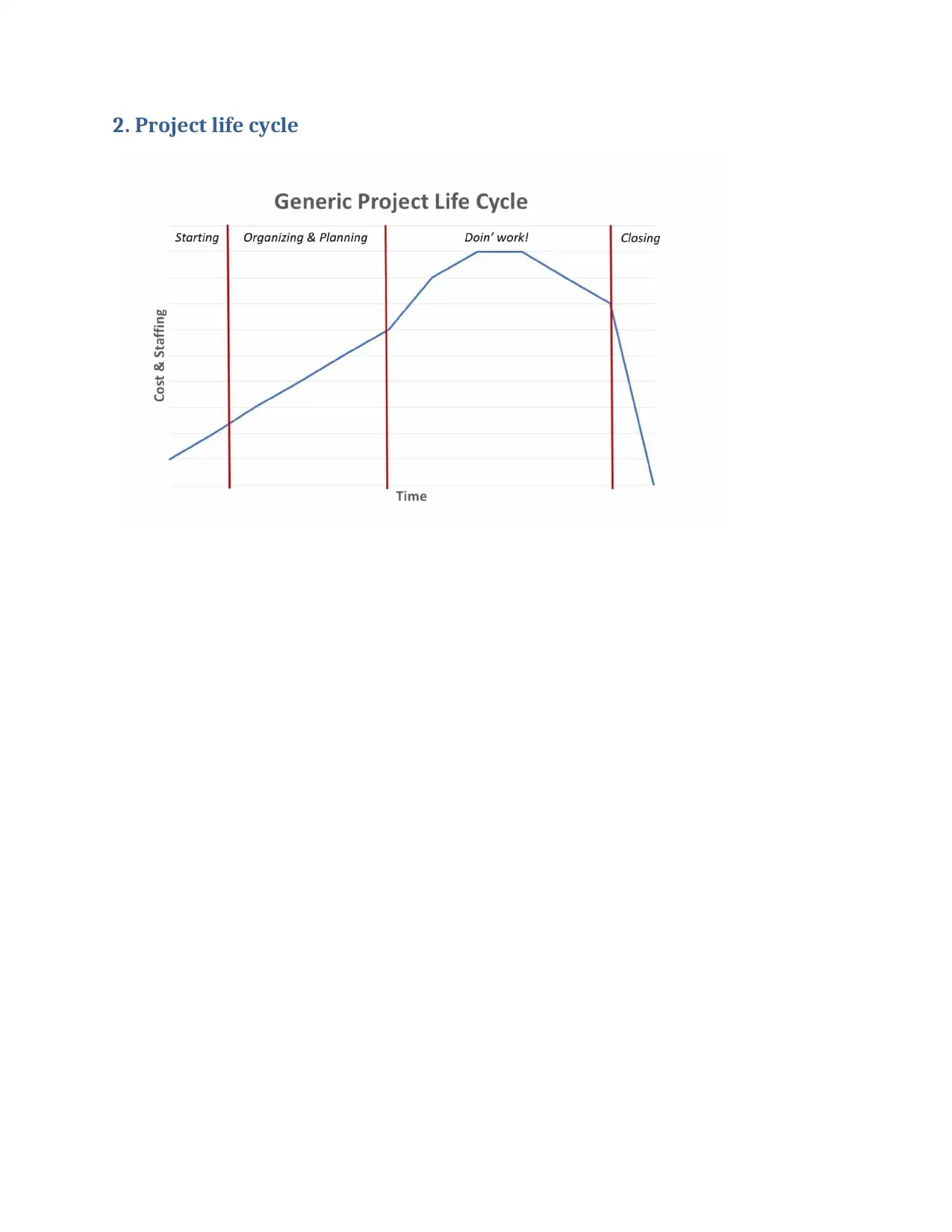
2. Project life cycle
1 out of 11
Related Documents
Your All-in-One AI-Powered Toolkit for Academic Success.
+13062052269
info@desklib.com
Available 24*7 on WhatsApp / Email
![[object Object]](/_next/static/media/star-bottom.7253800d.svg)
Unlock your academic potential
Copyright © 2020–2025 A2Z Services. All Rights Reserved. Developed and managed by ZUCOL.





